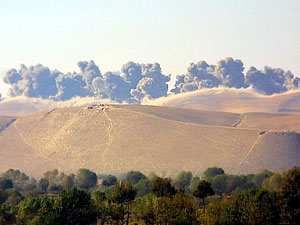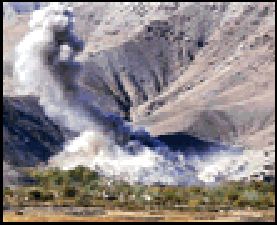| Situated about 100 miles from the Uzbekistan border, Mazar-e Sharif
is hardly a central city in Afghanistan, nor is it the country's most populated
or industrialized. It is not a Taliban stronghold like Kandahar or a political
symbol like Kabul.
But in a country with only a handful of major cities, experts say Mazar-e
Sharif serves a crucial role in supplying the Taliban and holding back
opposition forces. Several military, political and psychological factors,
they add, could make the city the first domino in the downfall of Afghanistan's
ruling Taliban.
1. Timing
Time and weather increased the pressure on opposition forces to move
on Mazar-e Sharif. With winter fast-approaching, a successful seizure of
the city would leave the surviving Taliban in the surrounding mountains,
cut off from food, ammunition and clothes. The upcoming Muslim holy month
of Ramadan, which starts next week, also factors into the U.S. and allied
time crunch Of course, if the Taliban were to re-take the city -- an ebb-and-flow
common in the years of battles between the two sides -- the tables would
be turned. The Northern Alliance forces themselves may be deflated militarily,
personally and physically, left out in the cold.
2. 'Land bridge'
U.S. military personnel are currently perched along the Uzbek-Afghanistan
border north of Mazar-e Sharif, ready to rush in food, clothing and other
aid to civilians, as well as military equipment and supplies for Northern
Alliance forces.
"We're interested in it because it would provide a land bridge up to
Uzbekistan, which provides us, among other things, a humanitarian pathway
for us to move supplies out of Central Asia and down into Afghanistan,"
Gen. Tommy Franks, commander of U.S. forces in southwest Asia, said Thursday.
U.S. troops could also move in, en masse and with heavy equipment, more
efficiently by land than by any other means.
CNN correspondents on the ground warn that poor terrain, weather and
roads may make re-supply over land a challenge, at least until the conditions
improve and the convoys can be protected. The Pentagon has said troops
from besides the United States might provide security along this land bridge.
3. Air bases
Since the U.S.-led military campaign began on October 7, most allied
strike aircraft have had to fly hundreds if not thousands of miles to reach
their targets. Setting up an airfield at Mazar-e Sharif's airport could
significantly accelerate and simplify U.S. operations.
The city's largest airfield is thought to be sub-standard, littered
with the remains of old Soviet tanks, and likely damaged by recent airstrikes.
It might also be a target for Taliban lurking in the surrounding mountains,
and has not been as sought-after as the Bagram air base just north of Kabul.
But the United States has the capability to quickly revamp such a facility
and defend it. Put into use, an airfield would give allied forces a staging
ground to fly in increased humanitarian aid, military supplies and possibly
U.S. forces, while launching airstrikes deeper inside Afghanistan.
4. Cutting off the Taliban
Mazar-e Sharif has served as a critical east-west and north-south pathway
ever since the days of Alexander the Great. That fact did not change under
the Taliban, which captured the city in 1998.
Military, food, oil and other supplies from north of the country --
be it Uzbekistan, Tajikistan or elsewhere -- have traditionally flowed
through Mazar-e Sharif first on their way southeast toward Kabul, west
toward Herat, or south to Kandahar. Given the U.S. airstrikes, an international
crackdown on Taliban and al Qaeda financial assets and the ruling militia's
general political isolation, the Taliban were likely struggling for food,
supplies and ammunition well before the fall of Mazar-e Sharif.
If that should happen, the Northern Alliance would effectively control
the northern section of Afghanistan -- clearly its strongest military position
in years. Especially if Kabul falls, the Taliban would find themselves
increasingly isolated in the nation's south.
5. Psychological impact
Experts concede Mazar-e Sharif's military, geographic and strategic
significance. But the psychological impact may be most important at all
to the Afghan, American and international public.
The fall of Mazar-e Sharif may persuade Afghan warlords, who have a
long history of switching to the winning side, to foresee the war's outcome
and actively throw their support behind the Northern Alliance and fellow
opposition forces. The city's religious significance -- the brother-in-law
of the Muslim prophet Mohammed is buried near a Mazar-e Sharif mosque --
adds to its potential impact.
In the United States, the capture of Mazar-e Sharif may quell domestic
concerns of a perceived lack of progress on the military front. It might
also serve to partially satiate some, such as Pakistani President Pervez
Musharraf and other Arab leaders, who have been calling for a quick end
to the U.S.-led military campaign in Afghanistan.

|

